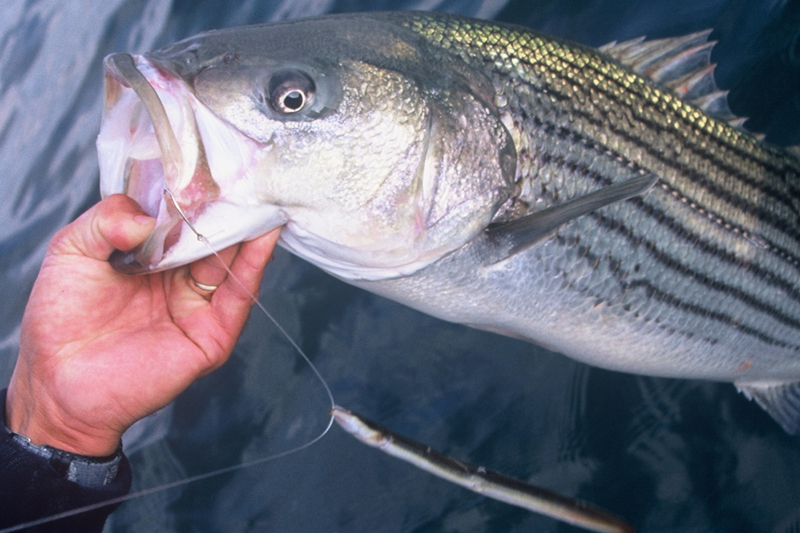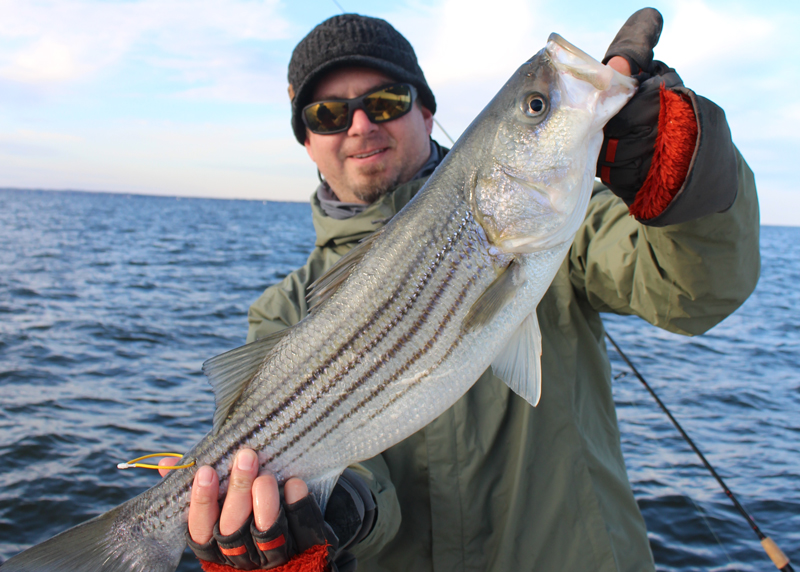Who says humans aren’t a migratory species? Keep a close eye on the roadways, and you’ll notice a late fall/early winter migration taking place — a migration of DelMarVa anglers headed for the ramp with boats in tow, ready to get in on the late season striped bass action. These fishermen are getting ready to target big fall fish throughout our region, from the shoals at the mouth of the Delaware Bay clear down to the CBBT. Ready to hook into one on light spinning or casting gear? Then head for the bait shop, and get yourself a bucket full of snakes.

The Eel Deal
As stripers run down the coast they’ll be caught by trollers and casters, so why should you focus your efforts on these slimy, squirmy, hard to deal with baits? Because small fish don’t eat them. Coastal regulations call for a minimum size of 28” and it’s rare to catch fish smaller than this when you sink an eel in the Atlantic. Even inlet anglers get an edge, as they increase the chance of an increased size fish taking the bait.
Eeling is most effective when you can pinpoint the fish at a particular structural break like the edge of a shoal or a coastal wreck, or where present, on a piling or series of pilings. Generally speaking, if the tide has the stripers in a feeding mood and you put a live eel in front of the fish, it’ll eat. So smart eelers will stick with a spot when they’re sure it holds fish, and work it through the tidal cycle even if they don’t catch anything at first. What’s the best piece of the tide? It varies from season to season and you’ll have to put in some time fishing (aw, darn!) to determine the pattern before you can put your foot down and say exactly when the fish will bite during any given time frame. That said, however, the hottest bite often begins at the peak of the current flow, which usually occurs an hour to a half hour before the change depending on your location. The good bite continues as the current drops, and may or may not continue as the current dies completely and then turns. If it does continue into the new tidal cycle, usually after a half hour or so it dies off.
Static Discharge
Once you’ve pinpointed a fish-holding location and arrived at the right time for a bite, you’ll have to decide whether to drift or anchor. Interestingly, how you fish depends greatly on where you fish. Along most coastal locations, like Overfall shoals at the mouth of Delaware Bay, Hen and Chicken Shoals off Delaware’s coast, and Little or Great Gull Shoals just outside of Ocean City, drifting the eels on bottom is the usual modus operandi. But at the CBBT and the mouth of the Chesapeake, anchoring up and fishing the eels under floats is the norm. When fishing along the rocks of any of the inlets along the coast, either method may be seen.
First, the drifters: you’ll want to rig up with a four- to five-foot leader of 40- to 50-pound fluorocarbon, terminating with an 8/0 to 10/0 live bait, octopus, or circle hook. Bait up by sliding your hook in through the eel’s lower jaw and out through the top of its upper jaw (note: some Virginia anglers are known to hook the eel through the tail, and they swear it works). Either slide an egg sinker over your main line or add a cigar weight between swivels attached to the main line and leader to weight the eel down. Both weighting methods have a good and a bad side. Using egg sinkers, the line can slide through the lead so the fish don’t feel any additional weight, but changing weights means cutting your line and re-rigging. Switching cigar weights is much faster and means just un-clipping your swivel, but it also means that the fish may detect a little something extra pulling on the line.
When a striper sucks your eel into its mouth, there will be a very distinct thump-thump-thump sensation. When this happens it’s imperative that you go into freespool or open the bail and let the fish eat, tension-free, for at least five seconds. By the time you reach five, the thumps should have ended and the striper should be pulling on the line consistently; it’s choked the eel down and is now swimming away. Fail to give that fish enough time to do so, and when you s-l-o-w-l-y apply tension to let the circle hook do its thing you’ll just be pulling the eel out of its mouth.

Eeling via float can be done with essentially the same rigging, except of course, you’ll downsize the weight and add a float to your line. Many anglers use large bobbers, but chunks of foam pool noodle work better. Simply cut one about two inches long, put a thick rubber band around it, and slide your main line through it before tying or clipping on your leader. Then hold the noodle as you let out the desired amount of line. When you have the proper depth set, pull two or three inches of slack line out through the noodle, and slip it under the rubber band. Tension will hold the line in place but as soon as a fish hits, it’ll pull the line from under the rubber band and allow the float to slide freely over your line while you fight the fish. Added bonus: when you’re night fishing you can push a cyalume light stick into the hole at the top of the noodle chunk for added visibility.
Remember that even in places like the CBBT, where large numbers of both small and large fish can both be found, as a general rule of thumb only the larger fish will attack a live eel. That alone should get you chilly weather anglers interested in grabbing a bucket of slime balls — and it should be enough to motivate you to take part in the “migration” this winter.
5 Bonus Eeling Tips
- Keep your eels in a Tupperware tub with holes punched in the bottom so slime can drain, and keep it inside your cooler. The chilly temps will slow down the eel’s metabolism and make them easier to handle, but as soon as they hit the water they’ll kick right back into high gear and start swimming.
- When drifting, you may think you detect hits without getting a hook-up. If this happens check your eel’s skin and look for circular scrape marks going all the way around the eel. If you find them, you’re getting hit and need to lengthen the time you allow the fish to chew before setting the hook. If you don’t see any circle marks, those “bites” are most likely just your weight bouncing along a rough bottom.
- Particularly early in the season if you feel two or three sharp, strong twangs on the line instead of the thumps, reel up and check your bait. Usually, you’ll pull in a half or a quarter of an eel, thanks to a bluefish. (Late in the season this problem usually goes away, thank goodness.) Rip it off and start over, because those stripers want an eel that’s whole, live, and wiggling.
- When moving, keep your eel on the hook, dangling in a bucket of water. Dangling, not resting, or it will twist all over itself and tie knots in your leader. And never put two eels in the same bucket or you’ll end up with a hopeless mess.
- When you need to handle a live and feisty eel, reach for a fresh paper towel. Rags work for a while but once they’re slimed you’ll need something new, so keeping a roll of paper towels onboard ensures easy bait-handling.
For more information on fishing with eels, check out How to Fish With Eels: Slime Factor.